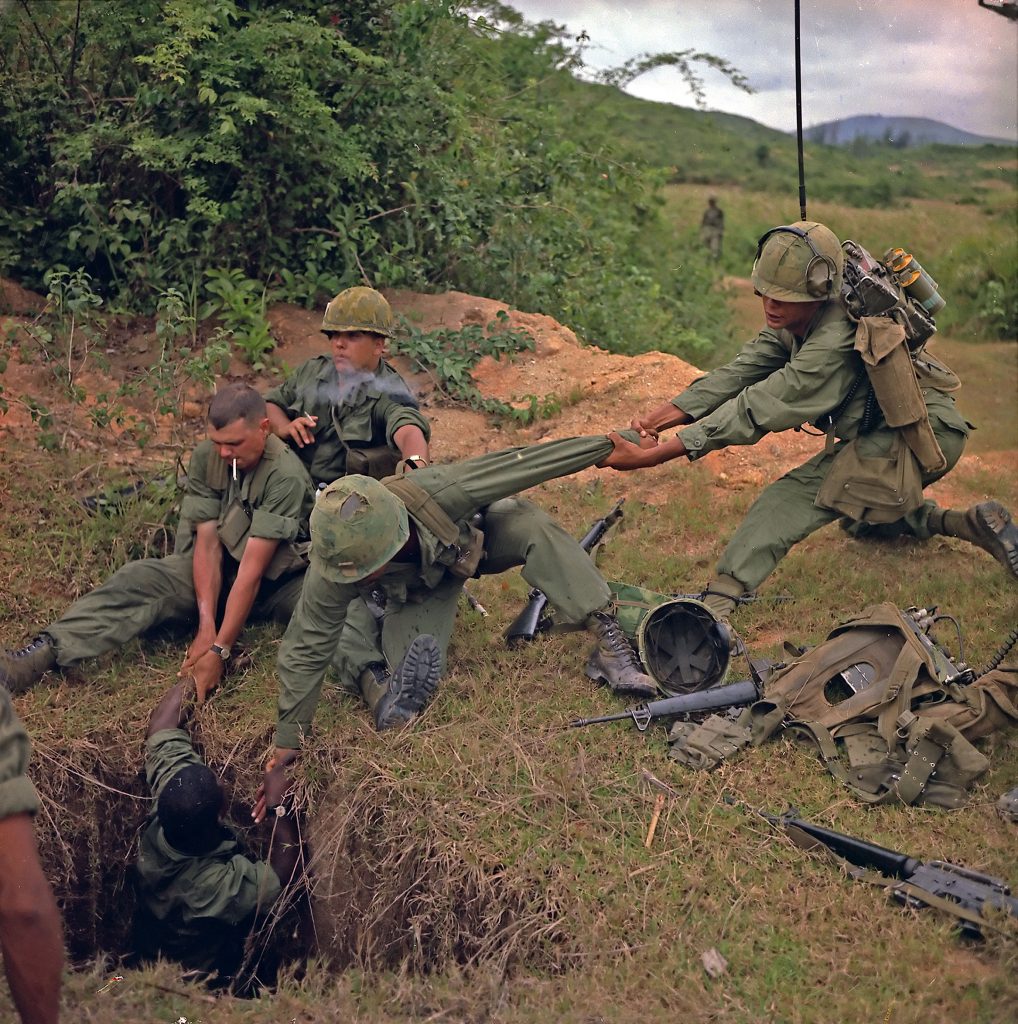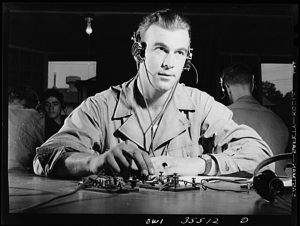If you ever see a flashlight coming your way, you can fire away, but more than likely, you are already a dead man.1
January 7, 1966. The war in Vietnam was raging and the United States had only just begun sending regular combat units as opposed to advisers the year prior. President Lyndon Baines Johnson was steadily escalating the United States’ involvement in Vietnam in an effort to “combat communism.” Eight thousand men descend on a freshly bombed area, hoping to clean up the remnants of Viet Cong in a search and destroy operation. However, when they approached the bombed area, known as the Ho Bo woods, they found nothing but empty fortifications and some rice, evidence that there were once many more men there. The leaders of the Joint American-Australian force were stumped. Where could the Viet Cong have gone?2

They received their answer when one young American soldier sat down to rest, then began exclaiming that he had been stung or bitten on his nether regions. As he began to search for the offending creature, he discovered that what had “stung” him was a nail, protruding from a wooden hatch. This hatch covered a massive underground complex known as the Cu Chi tunnels, spanning some fourteen miles; and this was only one of many tunnel complexes in South and North Vietnam.3 The presence of these tunnels meant that future search and destroy operations would be failures as well, if the tunnels were not dealt with. These tunnels gave the Viet Cong a way to attack U.S. troops from behind, after they had passed overhead; then they could quickly slip back into their tunnels and seemingly vanish. The tunnels also allowed them to hide during bombing runs and as American tanks and helicopters flew by, effectively hiding them from the brunt of American military might. The tunnels could be destroyed using explosives, but these tunnels housed barracks, ammunition and food depots, hospitals, clinics, armories, and rooms with vital military intelligence. These things were often too deep in the tunnels to be destroyed by a blast at the mouth of the tunnel, as the Viet Cong designed their tunnels so that blasts could only destroy small segments. The tunnels were very well made, with sharp right angles every few meters to baffle the blast of an explosive charge, and they had breathing holes dug by taking rabbits and gophers to the bottom of a tunnel and letting them dig themselves back to the surface. After several attempts using tear gas, Acetylene gas, and explosives to flush out the tunnels failed, a new plan emerged. Someone would have to enter the tunnels.4
And thus, the “tunnel rats” were born. These were men, generally small in stature to better fit the small tunnels designed for the smaller Vietnamese physique, and without fear of tight spaces or total darkness, although these are things many tunnel rats would develop after their time in the underground complexes. Armed with nothing more than a flashlight, which was hardly ever used for fear it would alert Viet Cong to the Tunnel rat’s location, a handgun, and a combat knife, sometimes wearing a battery-powered headset, connected to a long cable to let them relay information back to their comrades waiting at the mouth of the tunnel, these men would be lowered into a tunnel, and begin their search.5 Originally made up of men from the famous “Big Red One” 1st Infantry Division present at the original discovery of the Cu Chi tunnels, “tunnel rats” became an unofficial description for someone who had volunteered for this job. This work was mentally and physically taxing, with many volunteers giving up the duty after a few runs, or in many cases, a close call with a Viet Cong soldier in the dark confines of a cave.6
Part of the reason it was such a loathed experience was due to how dangerous an ordeal exploring the tunnels was. If an American tunnel rat were to run into a Viet Cong soldier, the encounter would devolve into hand to hand combat, as firing one’s pistol was very dangerous in tunnels that were barely shoulder-width.7 Firing the large .45 caliber M1911A1 pistol one was issued would definitely lead to ruptured eardrums. This led many of these men to bring captured Vietnamese-used Russian pistols or guns brought from home that were of a smaller caliber–.22 and .38 caliber revolvers being particularly common–that could be more safely fired in the small confines of the tunnels.8

The dangers did not end there either, as the tunnels were frequently booby-trapped, sometimes even with poisonous or venomous snakes and insects, or they had dangerous pits filled with water or gas designed to keep these things away from their living areas of the tunnels. The tunnels were frequently incredibly hot and humid, cramped, sometimes as small as 2.6 feet tall by 2.5 feet wide, and full of unpleasant stagnant air, prompting many tunnel rats to don gas masks in an attempt to make breathing easier.9 Even exiting a tunnel was not safe, as a tunnel rat could travel some distance while underground, then emerge elsewhere, potentially startling a nearby American soldier, which could lead to him being shot. Many tunnel rats would bring smoke grenades with them to use to alert any nearby troops that a friendly would be emerging from a tunnel.10 Because of these hardships, tunnel rats soon gained a reputation as being very courageous, smart, and incredibly lucky to escape a tunnel without dying, and the tunnel rats themselves began to use the motto “Non gratum anus rotendum” or “not worth a rat’s ass.”11
Even with these difficulties, the majority of tunnel rats were very successful. The tunnel rats of the 1st Infantry Division, the only one with any kind of formal training, was especially successful. Consisting of a number of men formally trained to enter the tunnels, radio operators to communicate with them, a medic and a pair of former Viet Cong who could act as translators, the team, led by Sargent Robert Woods, killed 3 Viet Cong soldiers and captured 153 more in a tunnel in August of 1968, just to name one of their most impressive raids. Outside of the formally trained 1st Infantry Division, the volunteer tunnel rats of other companies were sometimes successful as well, securing vital military intelligence, an enemy hospital, or sometimes stores of weapons; these captures accounted for a large portion of seized Viet Cong weapons.12
The tunnel rats where born out of necessity. The United States military had little experience with non-conventional warfare, and needed to adapt quickly to the guerrilla warfare employed by the Viet Cong. During the Vietnam War, even the Australian armed forces had their own “tunnel rats” whom they called “ferrets,” and with the Soviet war in Afghanistan in the 1980s, many Soviet soldiers faced similar hardships in the tunnels of the Mujahideen. Even today, the United States Marine Corps faces similar issues in fighting the Taliban in the cave-like “Kyareses,” or irrigation tunnels of Afghanistan.13 The tunnel rats of Vietnam were one of the first adaptations that the U.S. military made to prepare itself for a new type of warfare, unlike the conventional wars the U.S. had fought in before. But as the number of US casualties from Vietnam rose, American public opinion shifted from support to dissatisfaction, ultimately leading to the United States pulling out of Vietnam, but not before the United States military had learned valuable lessons about guerrilla warfare.

- James Gillam, “Death dance in the dark: James Gillam’s most terrifying moments in Vietnam came in the pitch-black darkness of an enemy tunnel,” Vietnam, 2011., 52, Academic OneFile, EBSCOhost ↵
- Encyclopedia of the Vietnam War: A Political, Social, and Military History, 2011, s.v. “CRIMP Operation,” by Chris Tomas. ↵
- Encyclopedia of the Vietnam War: A Political, Social, and Military History, 2011, s.v. “CRIMP Operation,” by Chris Tomas. ↵
- Encyclopedia of the Vietnam War: A Political, Social, and Military History, 2011, s.v. “Cu Chi Tunnels,” by Richard D. Starnes; “South Viet Nam: The Tunnel Rats,” Time, March 4, 1966. ↵
- Encyclopedia of the Vietnam War: A Political, Social, and Military History, 2011, s.v. “Tunnel Rats,” by James T. Gillam. ↵
- Encyclopedia of the Vietnam War: A Political, Social, and Military History, 2011, s.v. “Tunnel Rats,” by James T. Gillam. ↵
- “I’m not alone down here!” Vietnam, September/October 2015, 42. ↵
- “South Viet Nam: The Tunnel Rats.” Time, March 4, 1966. ↵
- Encyclopedia of the Vietnam War: A Political, Social, and Military History, 2011, s.v. “Tunnels,” by Scott R. Demarco. ↵
- “I’m not alone down here!” Vietnam, September/October 2015, 42. ↵
- George C. Herring, “Vietnam Remembered,” The Journal of American History 73, no. 1 (1986): 152-64; Encyclopedia of the Vietnam War: A Political, Social, and Military History, 2011, s.v. “Tunnel Rats,” by James T. Gillam. ↵
- Encyclopedia of the Vietnam War: A Political, Social, and Military History, 2011, s.v. “Tunnel Rats,” by James T. Gillam. ↵
- Timothy Gusinov, “‘Kyareses’: Taliban’s Death Trap or Escape Route?” Military Intelligence Professional Bulletin 28, no. 2 (April 2002): 46. ↵



58 comments
Santiago Sustaeta
It was very impressive how the Viet Cong managed to build these advanced tunnels and live down there. They managed to even hold hospitals which is crazy to me. This article was very informative and actually taught me some new information. It was interesting to read and the title got my attention right away. The pictures made the article even more enjoyable. Nice job
Suvesh Vasal
This article was extremely interesting and enjoyable to read. I had never really heard of the Tunnel Rats but I’m glad I read this article. It is incredible that they were able to navigate the tunnel with so much looming danger nearby. I could not imagine being in a small tunnel with nothing but a handgun, a knife, and a flashlight. These men were very brave I am sure they were highly respected by their fellow soldiers.
Tyler Thompson
This was a very interesting article! It’s crazy that some soldiers would risk their lives by going into these enemy tunnels. It was very strategic of the Vietnamese people to make the tunnels very small to fit their physique. It was also very crazy to know that a new form of warfare was developed underground, and that the U.S. Government flourished off of the idea of the “tunnel rats”.
Thomas Fraire
I was more than mindful that the Viet Cong utilized passages amid the war with a specific end goal to escape and snare the adversary, however I didn’t know how little these passages were. By and by I would not have any desire to be caught in that limited space, yet it’s astonishing how a few people could adjust to it. I additionally discovered it to a great degree charming that the passages were constructed so a touchy would decimate sections of the passage as opposed to demolish the imperative parts of the passages. This was an extremely fascinating article.
Hector Garcia
I can’t begin to explain how courageous these men had to be in order to enter the tunnels during the Vietnamese War. This task would have definitely been one of the deadliest since the tunnels were booby-trapped or they might have a lethal creature roaming in these tunnels. Overall, I thought that it was a particular topic that is rarely mentioned in history. This article seemed to be well-researched and it had a great attention to detail.
Grady Purcell
The Vietnam War was a war that was truly brutal and was one that clearly started an uproar in the states. I was aware of some of the conditions there but clearly not all of them, these tunnels were so confined in space and it’s hard to believe people fit in their and actually adapted to being in there over time. I also found it very interesting that an explosive down there would not destroy the important part of the tunnels, but only little segments of it.
Joshua Castro
I was more than aware that the Viet Cong used tunnels during the war in order to escape and ambush the enemy, but I wasn’t aware how small these tunnels were. Personally I would not want to be trapped in that confined space, but it’s amazing how some people were able to adapt to it. I also found it extremely intriguing that the tunnels were built so an explosive would destroy segments of the tunnel rather than destroy the important parts of the tunnels. This was a very interesting article.
Carlos Vazquez
The period of the Vietnam war was one of the most difficult times for the US military and for the government. This war required the Military to adapt to situations they had never experienced. The implementation of the “tunnel rats” allowed the soldiers to advance and win battles in the thick jungle of Vietnam. This article is very well written.
Samuel Stallcup
I remember reading about World War I and trench warfare, and I remember how disgusting and sickening these environments were. The Viet Cong were ruthless, and this article shows how ruthless these soldiers were. It’s a little surprising that it could somehow get worse for soldiers, and this article does a good job at showcasing the the literal hell these soldiers went through.
Timothy ODekirk
The war of Vietnam always intrigued me. And the intro to this article really hooked me and made me want to read further in to this incredible story. I only have a somewhat broad understanding of the Vietnam war, so I don’t know much about it. But, after reading this I discovered a new concept of the war, which was “tunnel rats”. “Tunnel rats” were incredibly interesting to me, because there were people who went into these creepy tunnels to smoke men out of there. War is never a good time or place to be in, but the War of Vietnam in particular is still interesting and will always be as time moves on.